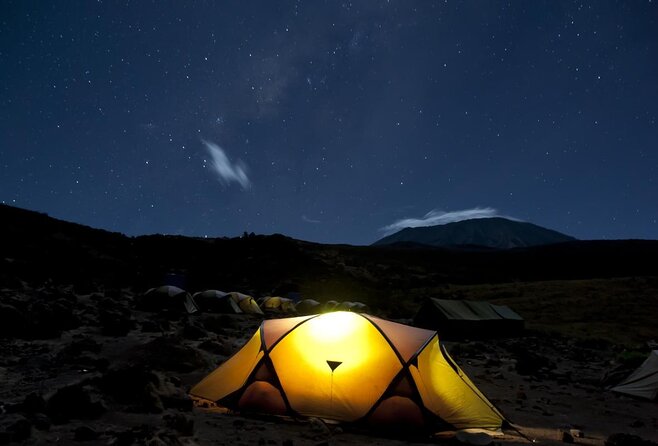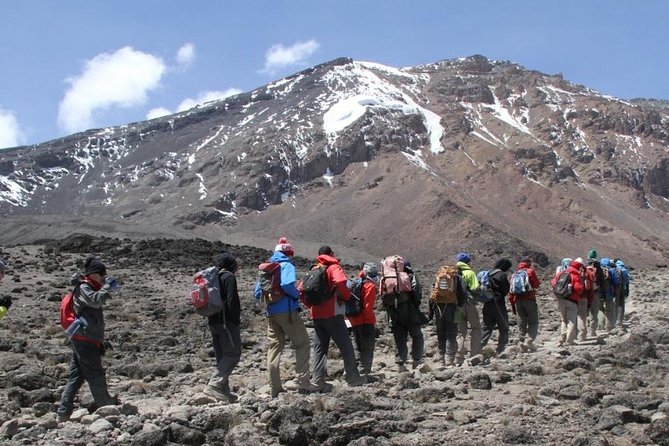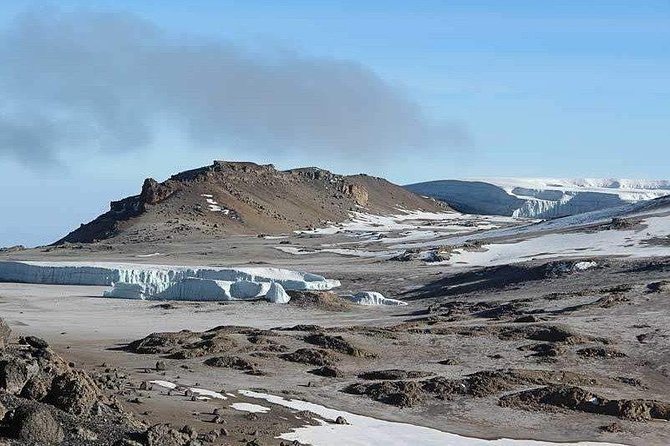Scaling the majestic Mount Kilimanjaro through the Machame route is a thrilling adventure that challenges even the most seasoned trekkers. This 7-day journey immerses explorers in the mountain’s diverse ecosystems, from lush rainforests to the barren summit. Along the way, they’ll encounter breathtaking vistas, push their physical limits, and experience the camaraderie of a shared expedition. For those seeking an unforgettable mountaineering challenge, the Machame route promises an unparalleled test of endurance and a chance to conquer the highest peak in Africa. What lies in store for those who dare to embark on this remarkable journey?
Key Points

- The 7-day Kilimanjaro trek follows the challenging Machame route, guiding adventurers through five distinct climatic zones, and is geared more towards seasoned climbers.
- The trek includes park fees, camping equipment, professional mountain guides, 3 meals daily, and accommodation before and after the climb.
- On the first day, hikers trek through lush rainforests and reach Machame Camp, situated in a beautiful alpine meadow.
- The trek involves ascending through the moorland zone, witnessing the dramatic shift in landscape, and reaching the Shira and Barranco camps.
- The final days include the summit push to Uhuru Peak, the highest point on Mount Kilimanjaro, followed by the descent to Mweka Gate.
Overview

This 7-day trek to Mount Kilimanjaro follows the challenging Machame route, guiding adventurers through five distinct climatic zones on their journey to the summit.
Geared more towards seasoned climbers, the trek offers a strenuous but rewarding experience, with tent-only accommodation throughout.
Trekkers will navigate diverse landscapes, from lush rainforests to barren alpine deserts, as they ascend to the snow-capped peak.
The route is known for its scenic beauty and technical difficulty, making it a popular choice for experienced hikers seeking a true mountaineering challenge.
With the guidance of professional mountain crews, participants can expect a well-supported expedition as they push themselves to conquer one of Africa’s most iconic natural wonders.
Here are more great tours and experiences we've reviewed in Arusha
Inclusions
The 7-day Kilimanjaro trek through the Machame route typically includes park fees, camping fees, and rescue fees, as well as the 18% VAT on all tour fees and services.
The package provides mountain tents, sleeping mats, and other essential camping equipment for the group’s use throughout the journey. Transportation to and from the mountain gate is also included, ensuring a seamless start and end to the adventure.
The trek is led by professional mountain guides, cooks, and porters who provide 3 meals daily and filtered water throughout the trek. Accommodation in Moshi before and after the climb is also provided, along with airport transfers, making the entire experience hassle-free for the climbers.
Exclusions

Flights, tips to the mountain crew, and items of a personal nature aren’t included in the 7-day Kilimanjaro trek through the Machame route package.
Laundry services and the optional portable flush toilet with a toilet tent (an extra $65 per toilet and tent) are excluded from the overall costs.
Travelers should be prepared to pay for their flights to and from the starting point in Moshi, Tanzania.
They’ll also need to factor in tips for the experienced guides, cooks, and porters who’ll be assisting them throughout the challenging trek.
Any purchases or expenses unrelated to the core trek package, like souvenirs or extra equipment, will be the responsibility of each individual participant.
Day 1: Machame Gate to Machame Camp
The trek kicks off with a drive from Moshi to the Machame Gate, where climbers will register and begin their ascent of Mount Kilimanjaro along the Machame route.
This 7-hour hike takes trekkers through the lush rainforests of the mountain’s lower slopes. Along the way, they’ll encounter:
- Towering trees draped in vines and mosses
- Colorful birds and other wildlife
- Stunning views of the surrounding valleys
The trail gradually ascends, with the group eventually reaching Machame Camp, situated in a beautiful alpine meadow.
After a long day of trekking, climbers will enjoy a delicious dinner prepared by the expert mountain crew before retiring to their tents for the night.
Day 2: Machame Camp to Shira Camp
After a restful night at Machame Camp, climbers embark on the trek to Shira Camp, which takes 4-6 hours to complete. Ascending through the increasingly sparse vegetation, they witness a dramatic shift in the landscape as they leave the lush rainforest behind and enter the moorland zone. The path winds its way up the mountain’s western slope, offering breathtaking views of the surrounding peaks and valleys.
| Terrain Type | Elevation (m) | Vegetation |
|---|---|---|
| Moorland | 3,800 | Heath, shrubs, and grasses |
| Senecios | 4,000 | Giant Senecios and Lobelias |
| Barren | 4,200 | Sparse, hardy plants |
| Scree | 4,600 | Loose rock and gravel |
| Glaciers | 5,000+ | Permanent ice and snow |
The trek to Shira Camp is a significant milestone, as climbers begin to acclimate to the increasingly thin air and prepare for the challenges that lie ahead.
- Tanzania Wildlife Encounters – 6 Days
- Private 6-Day Tarangire Manyara Crater and Serengeti With Mid-Range Lodges
- 6 Days Private Budget Safari
- 5-Day Highlights Mid-Range Crater, Serengeti, Tarangire
- 8-Day Small-group Lemosho Kilimanjaro Summit Trekking
- 4-Day Safari From Arusha: Tarangire, Serengeti and Ngorongoro
Day 3: Shira Camp to Barranco Camp
Climbers leave the serene Shira Camp and embark on the trek to Barranco Camp, a journey that takes 4-5 hours through the Lava Tower and a gradual descent to the valley below.
The hike provides stunning views of the surrounding landscape, including the towering Lava Tower at 15,190 feet (4,630 m).
Along the way, trekkers may encounter:
- The Lava Tower, a challenging climb that tests their endurance and acclimatization.
- The gradual descent to Barranco Camp, offering a respite from the strenuous ascent.
- The breathtaking vistas of the Kibo and Mawenzi peaks, which serve as a constant reminder of the magnitude of their undertaking.
Reaching Barranco Camp marks an important milestone in the Kilimanjaro climb, as climbers prepare for the next leg of their adventure.
Day 4: Barranco Camp to Karanga Camp
From Barranco Camp, trekkers embark on the journey to Karanga Camp, a 4-5 hour trek through the dramatic Barranco Valley.
Navigating the iconic Barranco Wall, often referred to as the ‘Breakfast Wall,’ challenges climbers to scale this steep, rocky section using their hands and feet. Upon reaching the top, they’re rewarded with awe-inspiring vistas of the surrounding glaciers and peaks.
The descent into the Karanga Valley offers a brief respite before the final push to high camp. Trekkers must be prepared for the increasing altitude and rugged terrain as they make their way towards Barafu Camp, the launching point for the summit attempt on the following day.
Day 5-7: Kilimanjaro Summit and Descent
Trekkers press on from Karanga Camp, embarking on the penultimate leg of their Kilimanjaro journey as they make their way to Barafu Camp, the base for their summit attempt.
The ascent is grueling, with trekkers navigating steep switchbacks and rocky terrain.
Upon reaching Barafu Camp, they prepare for their midnight departure to the summit.
The final push to Uhuru Peak is both physically and mentally demanding, but the spectacular views from the rooftop of Africa make the challenge worthwhile.
After a triumphant moment at the summit, trekkers begin their descent, navigating the steep scree and returning to Mweka Camp for their final night on the mountain.
The final day’s hike to Mweka Gate marks the end of an incredible Kilimanjaro adventure.
Frequently Asked Questions
What Is the Average Success Rate for the Machame Route?
The Machame route has an average success rate of around 85-90%, making it one of the more popular and successful routes up Mount Kilimanjaro. Its challenging nature attracts seasoned climbers, who often achieve their goal of reaching the summit.
How Difficult Is the Machame Route Compared to Other Kilimanjaro Routes?
The Machame route is considered one of the more challenging Kilimanjaro treks, requiring greater endurance and fitness than other routes. It traverses several distinct climate zones, making for a grueling yet rewarding climb for experienced hikers.
What Are the Most Common Altitude-Related Issues on the Machame Route?
The most common altitude-related issues on the Machame Route are altitude sickness, fatigue, headaches, and loss of appetite. Proper acclimatization, hydration, and pacing are crucial to minimizing these effects and successfully reaching the summit.
What Type of Training Is Recommended for the Machame Route?
To prepare for the Machame route, climbers should focus on cardio and strength training to build endurance. Hiking with a weighted pack, climbing stairs, and incorporating high-altitude simulations are also recommended to acclimate the body to the challenging terrain.
How Do the Temperatures Vary During the Machame Trek?
The temperatures on the Machame trek vary significantly, ranging from warm and humid at the base to freezing at the summit. Trekkers experience a wide array of climatic conditions as they ascend through the different ecological zones of Kilimanjaro.
Recap
Trekkers on the Machame route of Kilimanjaro will experience an unforgettable journey through five diverse climatic zones, culminating in the grueling summit push to Uhuru Peak.
With stunning vistas, experienced guides, and quality camping equipment, this challenging 7-day trek offers adventurers a true mountaineering adventure.
Those seeking a remarkable Kilimanjaro experience won’t be disappointed by the Machame route’s breathtaking natural landscapes and sense of accomplishment upon reaching Africa’s highest point.
More 7-Day Experiences in Arusha
- 7 Days PRIVATE Best of Tanzania Safari *Departing Everyday*
- 7 Days Tarangire, Serengeti, Ngorongoro & Manyara Camping Safari Tour Tanzania
- 7 Day Joined Safari Serengeti,Ngorongoro,Manyara,Tarangire,Arusha National Park
- 7 Days Kilimanjaro Climb Machame Route
- 7 Days Journey of the Wildebeest – Luxury Holidays Serengeti
- 7-Day Safari (Including Serengeti) & Zanzibar Extension
More Tour Reviews in Arusha
Not for you? Here's more things to do in Arusha we have recnetly reviewed
- 20 Best 2 Day Tours In Arusha
- 20 Best 3 Day Tours In Arusha
- 20 Best 4 Day Tours In Arusha
- 3 Best Food Tours In Arusha
- 4 Best Full-Day Tours In Arusha
- 21 Best Coffee Tours And Tastings In Arusha
- 5 Days Marangu Route – Mount Kilimanjaro Trek
- 7 Days Great Wildebeest Migration Mara River Crossing
- Fly Inn to Central Serengeti From Zanzibar Featuring Ngorongoro & Tarangire Park
- 5 Days Tanzania Big 5 Safaris
- Tanzania Wildlife Safari Budget Camping
- 2 Days Mid-Range Tanzania Private Safari – Tarangire & Ngorongoro
